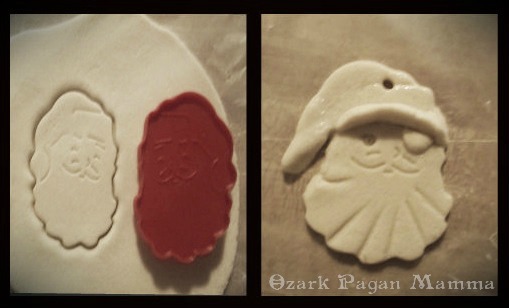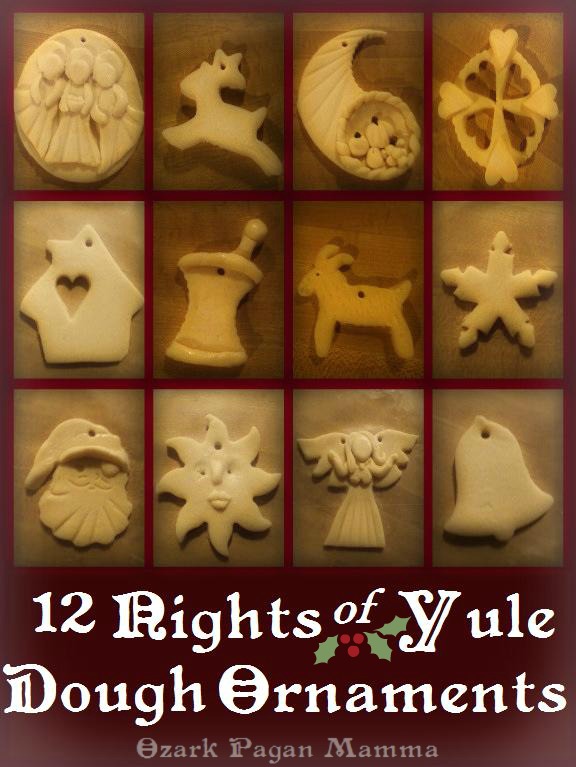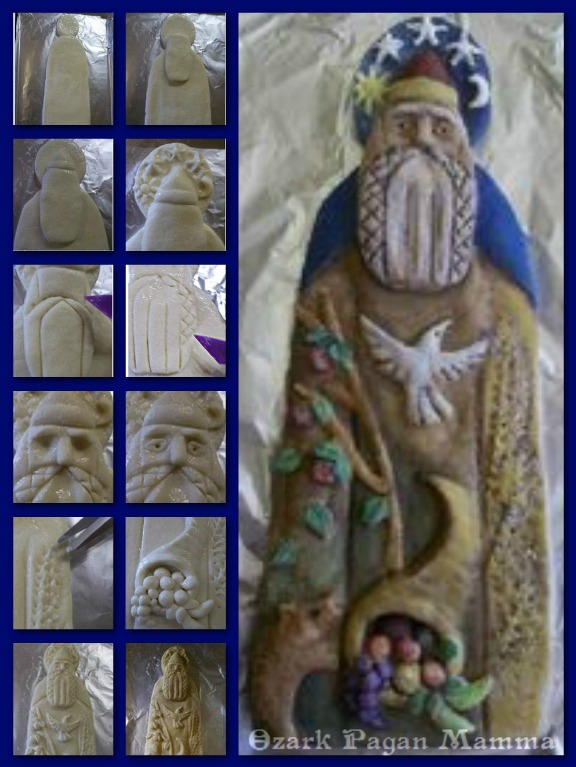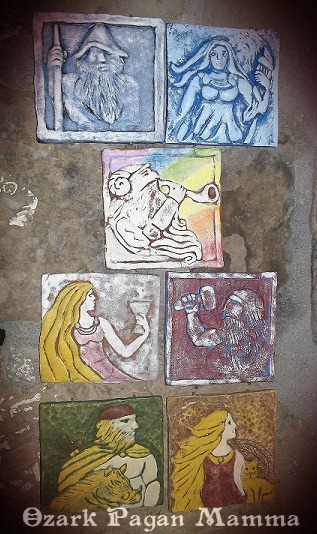Simple symbols crafted in dough is a classic craft to help kids celebrate the 12 Nights.
Salt dough can last a long time if stored well. You can add cinnamon for color and scent. Apple cinnamon dough is another alternative with a darker color and stronger scent. Besides the dough ingredients, you’ll need a flat working surface, rolling pin, cookie and biscuit cutters, a butter knife, toothpick (and/or any clay tools you might like to use), a straw (for making a hole for hanging), and wax paper on a tray or piece of cardboard (for drying). After the ornaments dry, you’ll need string or ribbon for hanging.
Some of the symbols are pretty straight-forward cookie cut-outs, for others, there’s a little bit of method involved. Evenly roll out your dough to a medium thickness; too thin and it will break easily, too thick and it will weigh too much to hang on your Yule tree. Remember to lightly dampen dough with water when joining pieces or adhering to a base layer.
For the 1st Night of Yule, sacred to Frigga and the Dísir (ancestral guardian mothers), make a Three Matronae ornament. Roll out your dough and cut out a circle using a medium lid as a template. Cut out three triangles and attach to the circle side by side. Cut out three circles with a small circle cutter or bottle cap, and attach to base above triangles to represent hair or halos. Roll out smaller circles for their heads and flatten just above triangles. Roll out little coils of dough for their arms. Make little half circle bowls for one or more of them to hold. Poke a hole in the top for hanging and set aside to dry.

For the 2nd Night of Yule, the night of the Wild Hunt, simply roll out the dough and use a cookie cutter to cut out an animal shape that represents the Hunt. A horse is a good one, and so is a hound. It is easy to find deer cookie cutters and this would work nicely as well. Use tools to etch in details and texture, if you like. Poke a hole in the top for hanging and set aside to dry.
For the 3rd Night, the High Feast of Yule, make a cornucopia. Roll out your dough and cut out a large circle shape, using a biscuit cutter or lid. Use a small biscuit cutter (about 1/2 the size of the big one) to cut away a piece from the edge of your dough circle to where you have a fat crescent. Place a biscuit cutter over one of the crescent ends. Press down on one side only to round out and trim away the end. Roll out a dough coil and form into a circle to place on the rounded end of the dough circle. Use your thumb to indent dough inside coiled ring. Add little dough balls to represent fruit. (You can press in whole cloves for fruit stems.) Use the handle of a butter knife to press ridges into the cornucopia. Poke a hole in the top for hanging and set aside to dry.

The 4th Night of Yule is sacred to Freya, Njörd, and Ægir, but we like to honor the whole of the Vanir gods as well. The wagon wheel is a symbol of the Vanir, and the heart is a symbol for Freya. To make this wagon wheel ornament, roll out your dough and use a lid or biscuit cutter to cut out a circle. Using a small heart cutter, cut our four hearts around the center, with points toward the center. This establishes a four spoke wheel. Take the hearts that were cut out and attach around the edges between the cut out hearts.

For the 5th Night of Yule, the night of community, use a cookie cutter to cut out a house shape, and a small cutter to cut out a window. Alternatively, you could cut out out several people with cookie cutters and join their hands together. Poke a hole in the top for hanging and set aside to dry.
For the 6th Night of Yule, sacred to Eir, goddess of healing, make a mortar and pestle. Roll out dough and use a large biscuit cutter to cut out a circle. Use the same biscuit cutter to trim pieces out of both sides to resemble a mortar. Use a butter knife to cut a straight bottom. Attach a coil shape to the top (at a sideways slant) and a flatten a ball shape to the top of the coil. Make dough coils for the top and bottom rims of the mortar and attach. Poke a hole in the top for hanging and set aside to dry.

For the 7th Night of Yule, sacred to Thor, make Thor’s goat. Roll out you dough and use a goat cookie cutter to cut out the shape. If you don’t have a goat cookie cutter, use a deer cookie cutter instead; after you have cut out the shape, trim away the antlers and replace with little coils of dough to resemble goat horns. Use a fork to scrape in fur texture, or press some dough through a garlic press and attach to goat. Poke a hole in the top for hanging and set aside to dry.
For the 8th Night of Yule, sacred to Skaði and Ullr, make a snowflake. If you don’t have a snowflake cookie cutter, you can use a star cookie cutter. Roll out your dough and use the pointy end of a small heart cookie cutter to cut two notches out of the sides of each star point. Poke a hole in the top for hanging and set aside to dry.

For the 9th Night of Yule, sacred to Odin, make a Yule Father ornament. Roll our your dough and use a Santa cookie cutter to press out your shape. You can make the ornament look more like Odin by pinching the top of the hat to make it pointy (instead of pom-pom topped), and pinching up a hat brim. You can also make him an eye patch. Press in face details with a toothpick or other tool. Poke a hole in the top for hanging and set aside to dry.

For the 10th Night of Yule, sacred to Sunna and the Ancestors, make a sun ornament. If you don’t have a sun cookie cutter, use a flower cookie cutter instead. See my sun plaque article for tips on making a sun face. Poke a hole in the top for hanging and set aside to dry.
For the 11th Night of Yule, sacred to all of the goddesses and the Valkyrie, make a goddess/Valkyrie ornament. Roll out your dough and cut out a triangle shape. Cut out and attach two teardrop shapes to the triangle sides. Attach a cut out of an upside down heart over the top of the triangle, and a flattened dough ball above this. Use the handle of a butter knife to press in skirt folds. Use coiled dough to make the arms and hair. (Alternatively, you could use an angel cookie cutter to make this ornament.) Use toothpick or other tools to add details, if you like. Poke holes in the top of each wing for hanging and set aside to dry.

For the 12th Night of Yule, Oath Night, sacred to all the gods, make either an Oath Night pig, or a bell to ring in the New Year. Roll out your dough and use your choice of cookie cutter to cut out your shape. Use tools to add details, if you like. Poke a hole in the top for hanging and set aside to dry.
When your ornaments are dry, you can paint them. If you added cinnamon to your dough (or used apple cinnamon dough), you will want to let the dough show instead of painting over it. But you may want to use a little bit of white puff paint on dark dough for accents and contrast. When paint is dry, lace a string or ribbon through the hole for hanging.
Parents, you can use the ornaments to help your child commemorate each Night of Yule… have each of them put away in their own individual drawstring bags (or drawers in a box), and have your child take out each ornament on it’s specified day and hang on your Yule tree.
























